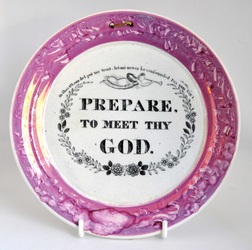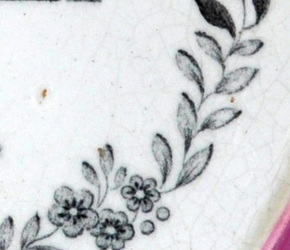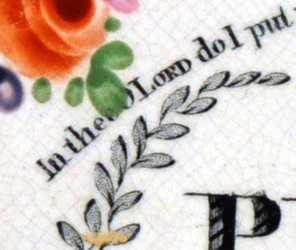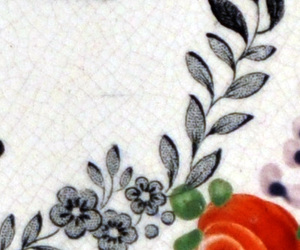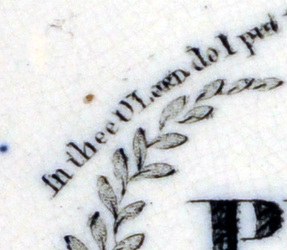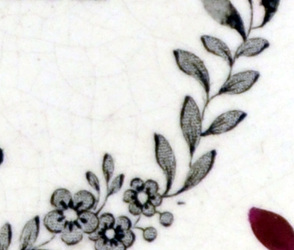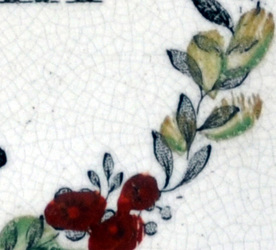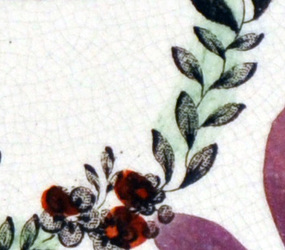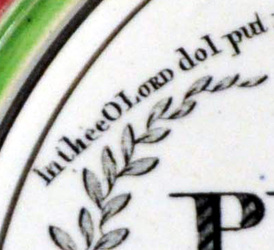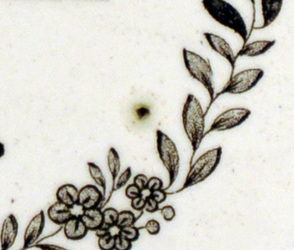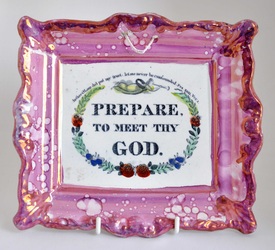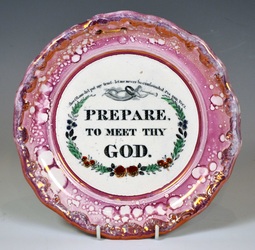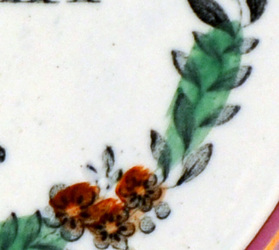|
I had the idea that if you arranged details of all the Scott-attributed 'Prepare' plaques in columns (the ones with 'thee' in the top verse), one plaque above another, you'd be able to put them in chronological order, depending on where they belonged in terms of the life cycle of the transfer plate, i.e. I expected a graduated fading of the imprint, and then points of refreshment where re-engraving occurs. When ordering the photos, I considered the following points:
This first plaque is attributed to Newbottle c1830s (see my previous post). The imprint is bolder because the deeper grooves of the newly engraved transfer plate hold more ink. The next two plaques could either be Newbottle or Scott. Baker writes that Newbottle produced pink lustre wares. But my guess is they are later in form and belong to the Scott era, c1840s. They probably post date the two plaques below them, as the imprint is fainter, i.e. the grooves on the transfer plate have worn shallow and hold less ink. The two forms below are Scott-attributed, and appear with other Scott transfers, e.g. Cast Iron Bridge over the River Wear, and the Mariner's Compass. At this point, my chronology fell flat. No matter how hard I tried to arrange the sequence of transfers, I could find no evidence for the change in the shading of the leaves being due to re-engraving. The first plaque below is almost certainly 1830s, and yet, unlike the plaques above, the leaves on the left of the sprig are shaded most heavily on their left side (see right column photos). So the following plaques were produced FROM A DIFFERENT TRANSFER PLATE. The seven plaques that follow are indisputably from the same copper plate, as they all have an identical flaw – a small horizontal mark to the right of the third flower (see right column photos). The first plaque is from an unknown pottery, though could possibly be Scott. All the others are plaque forms associated with Scott. Note that the next two plaque forms also appear in the section above with the 'Newbottle' transfer plate. So the two transfer plates were in use simultaneously on the same plaque forms. The four plaques below are of the brown-bordered variety most commonly attributed to Scott (c1850s-c1870s). For anyone thinking, phew, well that's all sorted now, think again. The two items below don't fit either of the transfer prints above. In the centre column of photos, note the shading of the leaf under the 't' in 'thee'. In both cases its most heavily shaded on the left side. That isn't true for any of the plaques above. Note that even though the leaves are shaded similarly (in the third column photos) to the plaques above, neither the plaque nor the bowl below has the transfer flaw to the right of the flower. So we started off with two sets of Scott transfer plates ('the' and 'thee') and now have at least four! And what about the fabulous circular red-and-green-bordered plaque (see below) I mentioned in my last post? Like the two Scott items above, the leaf under the 't' in 'thou' is shaded on the left side (so it's not Newbottle), and it doesn't have the flaw to the right of the flower. This morning I had an inspiration and remembered the two circular Moore & Co plaques from 'The Bottle' series, which are of this form. Satisfyingly, the transfer on the red and green plaque is an excellent match to those on the plaques I'd attributed to Moore & Co. Paradoxically, the marked Scott bowl, which I used as a basis for attributing brown-bordered plaques to Scott, appears to have a Moore & Co transfer! This doesn't, however, damage the attribution too much as there are Scott-marked bowls with ships and other transfers that appear on brown-bordered plaques.
So, back in the 1830s an enterprising engraver made at least four sets of transfer plates of these verses for the Sunderland potteries, apparently based on those used by C,C & Co in Newcastle. Scott seems to have, over time, acquired at least three of the sets. Perhaps partly to increase production, but surely also to monopolise the lucrative market in these verses. Re-engraving and restoration of the transfer plates, doesn't play as great a part as I thought, despite the long production period of these plaques. When one set of engravings wore thin, Scott could simply switch production to another. I think this is why the 'Newbottle' set doesn't appear on post-c1850s plaques, i.e. why there are no brown-bordered plaques with that transfer. Someday, when I feel stronger, I ought to take a closer look at the 'Thou gods'!
0 Comments
Leave a Reply. |
AuthorStephen Smith lives in London, and is always happy to hear from other collectors. If you have an interesting collection of plaques, and are based in the UK, he will photograph them for you. Free advice given regarding selling and dispersal of a collection, or to those wishing to start one. Just get in touch... Archives
February 2022
AcknowledgementsThis website is indebted to collectors, dealers and enthusiasts who have shared their knowledge or photos. In particular: Ian Holmes, Stephen Duckworth, Dick Henrywood, Norman Lowe, Keith Lovell, Donald H Ryan, Harold Crowder, Jack and Joyce Cockerill, Myrna Schkolne, Elinor Penna, Ian Sharp, Shauna Gregg at the Sunderland Museum, Keith Bell, Martyn Edgell, and Liz Denton.
|






